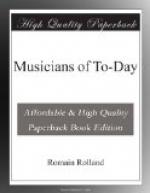“And from this
we know what great consideration is due to us in a
State; and how the science
of Fencing is far above all useless
sciences, such as dancing
and music.”
The first lectures on Aesthetics and Musical History were not given in France until after the war of 1870.[238] They were then given at the Conservatoire, and, until quite lately, were the only lectures on Music of any importance in Paris. Since 1878 they have been given in a very excellent way by M. Bourgault-Ducoudray; but, as is only natural in a school of music, their character is artistic rather than scientific, and takes the form of a sort of illustration of the practical work that is done at the Conservatoire. And as for Parisian musical criticism as a whole, it had, thirty years ago, an almost exclusively literary character, and was without technical precision or historical knowledge.
[Footnote 238: On 12 September, 1871, at the suggestion of Ambroise Thomas. The first lecturer was Barbereau, who, however, only lectured for a year. He was succeeded by Gautier, Professor of Harmony and Accompaniment, who in turn was replaced, in 1878, by M. Bourgault-Ducoudray.]
There again, on the territory of science, as on that of art, a new generation of musicians had sprung up since the war, a group of men versed in the history and aesthetics of music such as France had never known before. About 1890 the result of their labours began to appear. Henry Expert published his fine work, Maitres Musiciens de la Renaissance, in which he revived a whole century of French music. Alexander Guilmant and Andre Pirro brought to daylight the works of our seventeenth and eighteenth century organists. Pierre Aubry studied mediaeval music. The admirable publications of the Benedictines of Solesmes awoke at the Schola and in the world outside it a taste for the study of religious music. Michel Brenet attacked all epochs of musical history, and produced, by his solid learning, some fine work. Julien Tiersot began the history of French folk-song, and rescued the music of the Revolution from oblivion. The publisher Durand set to work on his great editions of Rameau and Couperin. Towards 1893 the study of Music was introduced at the Sorbonne by some young professors, who made the subject the theses for their doctor’s degree.[239]
[Footnote 239: The first three theses on Music accepted at the Sorbonne were those of M. Jules Combarieu on The Relationship of Poetry and Music, of M. Romain Holland on The Beginnings of Opera before Lully and Scarlatti, and of M. Maurice Emmanuel on Greek Orchestics. There followed, several years afterwards, M. Louis Laloy’s Aristoxenus of Tarento and Greek Music and M. Jules Ecorcheville’s Musical Aesthetics, from Lully to Rameau and French Instrumental Music of the Seventeenth Century, M. Andre Pirro’s Aesthetics of Johann Sebastian Bach, and M. Charles Lalo’s Sketch of Scientific Musical Aesthetics.]




